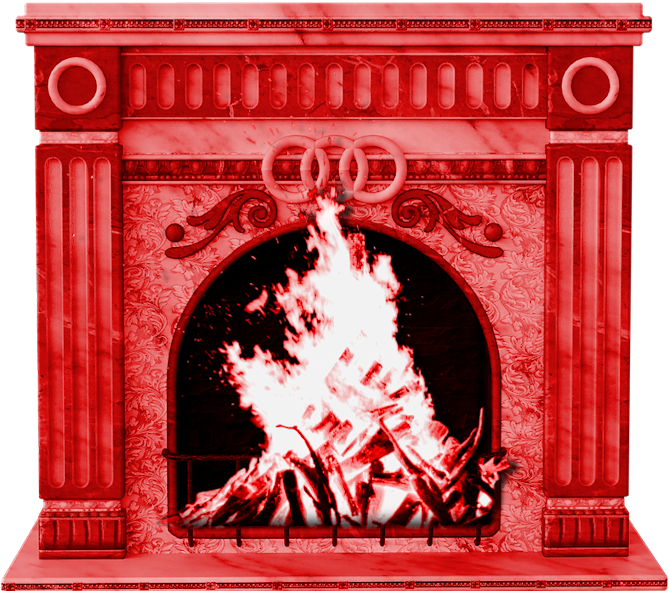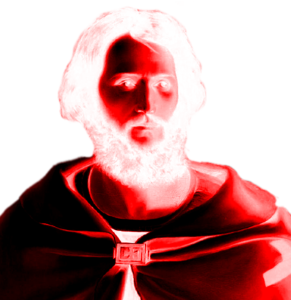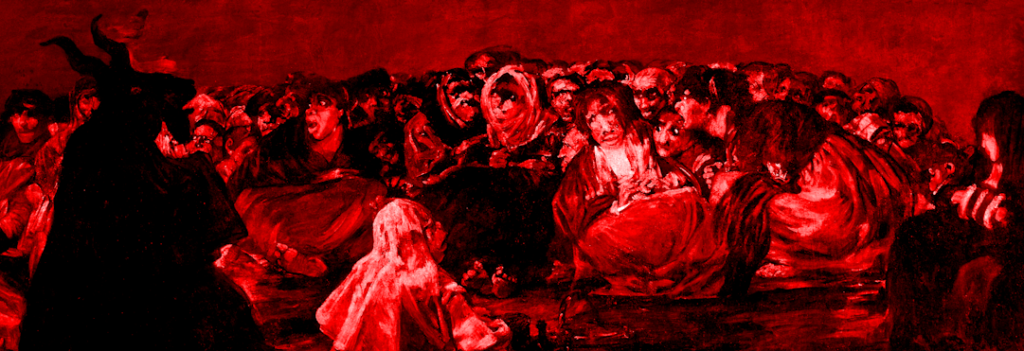Stealing Wicca’s Book of Shadows
What Power Art Thou
It’s been just over a year since the conferral of my Gardnerian 3rd-Degree elevation at the competent, properly-prepared, and delicate hands of a Grande Prêtresse de l’éternelle Dame Blanche.
Hyacinthe Collin de Vermont – Winter from Allegories of the Four Seasons

Critics have outweighed the kudos (as is common in Magic) – but none with more wounding words than an accusation that the rite was proffered through a ‘stolen Book of Shadows,’ a lie which rattles a bit too familiar to the taunts once-leveled at the late, great, Alex Sanders.
It occurred to me that this is how the powers that be 1 have worked in Gardnerian Witchcraft for several decades, and inspired me to share a curious story that it called to mind, whilst offering an in-depth parallel to certain themes of modern scholarship.
“Au milieu de l’hiver, j’apprenais enfin qu’il y avait en moi un été invincible (…In the depths of winter, I finally learned that within me there lay an invincible summer).”
– Albert Camus, Retour à Tipasa, 1952
Self-indulgence aside, it’s hoped that my thoughts here might enlighten the naive (or otherwise neglected) during this dark time of year, so that they postulate the right questions – and receive welcome assurances – from their would-be initiators.
In other words: don’t be fooled.
1-It may be more accurate to refer to them as “imagined powers.”
Horrors of the Hearth – A Historic Legend
This anecdote is prefaced with the caveat that I have no insight into its veracity, save for that it rang true – and was told to me as such, and surely echoes my own experience.
Craft aficiniados take note, it may be so that it has never before been written down.

“Passar al foco i di’ quieti e contenti (…to spend happy and quiet days near the fire)”
– Antonio Vivaldi, Sonetto L’inverno, op. 8 n. 4, RV 297
As it goes, perhaps the would-be ‘Witch King’ Alex Sanders himself once happed upon the ash-laden fireplace of a Gardnerian High Priestess (go figure, ‘they’ say he wasn’t one of us) – squinting through the soot, he spots a tangled web of string.
He curiously quizzes the tender of the hearth – “what are those?”
“The coven’s measures, dear,” Virbius is nonchalantly informed.
Horrified at this casual disrespect of the sacred trust between initiator and initiated (and wistful ignorance surrounding the Magical doctrines of sympatheia), Sanders incorporates key changes to his coven’s corpus of rites… the rest, as they say, is history:
“He had made bitter enemies of the most powerful and prominent witches in his region. A different personality would have given up at that stage; it is a measure of Sanders’s distinction that he did not.”
– Ronald Hutton, Triumph of the Moon, 1999 (emphasis mine)
How interesting, though, that one of the many insults slung at me (alongside accusations of ‘stealing the Book’) by the Gardnerian community’s hoi polloi is that Sanders must be “rolling in his grave” for my taking the allegorical theme of kingship as a literary motif.
“But it is I who am the ritual, I the sacrifice, the offering to the ancestors, the healing herb, the transcendental chant. I am the butter and the fire and the offering.”
– Bhagavad Gita, Chapter 9, Verse 16
It might just be said that it seems unlikely that Alex stole a damned thing (except, maybe, from the hermeticist Franz Bardon; or the angelic Madeline Montalban).
Neither have I, and the same can be said regarding the wonderful High Priestess whom elevated me to the 3rd Degree.
Words of the Wise
Well-known to most true Witches is the longstanding and respected rule-of-thumb amongst the so-called Long Island Line Gardnerians that published works are a reasonable hedge for intellectual citation.

“It is always possible to analyse the societal contexts in which a type of the witch-cult or practice appears; however this is peripheral and circumstantial to the inmost and a-temporal nature of the initiatory body.”
– Andrew D. Chumbley,
A Scattering of Dust from the Wings of the Moth, originally from
Chaos International (No. 19, Autumn 1995),
later – Opuscula Magica Volume II – Essays:
Witchcraft and Crooked Path Sorcery, 2011
It is also quite well-established that there is arguably no more thorough an analysis of the history of modern witchcraft, or ‘Wicca’ (actually, Wica) than 1999’s “Triumph of the Moon,” by the British professor Ronald Hutton, who was just recently awarded the nigh knightly nod of Commander of the Most Excellent Order of the British Empire (CBE) – owing to accolades which are nothing short of exceptional, daresay venerable along the discipline of Bede. Certainly, it must be so, since “Triumph of the Moon” was published by Oxford University Press.
Besides all that, even Bricket Wood-original Frederic Lamond had good things to say about the man in his “Fifty Years of Wicca” (2004). Ergo, referencing Hutton is about as reasonable for an initiate (such as myself) to do as citing the Oxford Dictionary.
These are important points (and not wrought of snark beyond wordplay), since the Craft ‘community’s’ hypocritical cretins who may suggest that I’ve somehow ruined a reader’s would-be initiatory experience for discussing them in my Work are sycophantic regarding popular scholarship. They will condemn my candidness here, despite recommending reading that betrays their cocky circumspection, while simultaneously steering Seekers toward avenues of abuse such as the exact topic being referenced.
Gazing at the ivory tower, then, it is Hutton who refers to a 1949 article in The Occult Observer, which was a publication (almost a mid-century ‘zine,’ if you will) that emerged from collaborations between the legendary, London-based Atlantis Bookshop’s then-proprietor, Michael Juste (romantically, “The White Brother,” his Magical autobiography from 1927 – also the publisher of Gerald Gardner’s “High Magic’s Aid” in 1949) and Ross Nichols, friend of Gardner who birthed the Order of Bards, Ovates, and Druids.

a contemporary to Gerald Gardner – the celebrity Indian palm reader Mir Bashir – used “The Book of Shadows”
as the title to his serialized article in “The Occult Observer” (Volume 1, Number Three), 1949
It’s that very snippet by a palmist named Mir Bashir, Hutton indicates, which made Doreen Valiente (notably the ‘fairy godmother’ of modern Wica) recognize in her “Rebirth of Witchcraft” (1989) that the very term ‘Book of Shadows’ itself was essentially stolen.
Ironically, Bashir’s titling is ornamentally crowned with a pentagram; and the same exact issue features an advertisement touting Gardner’s own “High Magic’s Aid” (with ‘stolen parchments’ being a key plotline, no less) as having been “just published!”
Tragedy of the Sun
The soothsayer Mir Bashir mentions the modus operandi of his idea of a Book of Shadows in 1949, but it is, to some extent, the fortunetellers of our modern era who pretend to rule over Witchcraft Today.

“With reasonable men, I will reason;
with humane men I will plead;
but to tyrants I will give no quarter,
nor waste arguments
where they will certainly be lost.”
– William Lloyd Garrison
You see, Hutton’s history stops where many of ours begins – with only the most coy reference to the New York Coven’s founding in 1963. In fact (small wonder) the name ‘Buckland’ is nowhere to be found in all of “Triumph.”
Back to Bashir, it’s the same piece which Hutton traces (through a 1996 SUNY academic journal contribution by James Baker) the practice of ‘taking the measure’ of a first-degree initiate. Hutton indicates that this is “regarded as to some extent as capturing them, so that the initiator can then either keep the cord in order to ensure that the initiate holds to the oath of secrecy (on pain of having destructive magic worked with the measure) or return it to the initiate as a sign of trust.”
Bashir describes an earlier (and more innocuous) Eastern technique which he claims to have observed in 1941

Bashir’s version is quite less morbid, and could even be described as charming – he outlines (ostensibly from first-hand experience in Bombay, or present-day Mumbai, circa 1941), a supposed Indian divinatory technique wherein a guru measures the shadow cast by the Sun around an individual in order to predict and prognosticate.
Measure Twice, Cut Once
I’ve previously touched on Buckland’s lament toward what the Craft became after his untimely retirement in the early 1970s – specifically, the sweeping modifications made under the ‘leadership’ of Theos and Phoenix.

“Gerald told me that ‘the measure was then buried
in a boggy place, with curses, so that as it rotted
so the traitor would rot.'”
– Doreen Valiente, as cited by Janet and Stewart Farrar, in
“A Witches’ Bible” (various editions, paired from two
earlier 1980s volumes, namely
“Eight Sabbats for Witches”
and “The Witches’ Way:
Principles, Rituals, and Beliefs
of Modern Witchcraft”)
These changes represented a far cry from the lofty links to a medieval witch cult, or even the Knights Templar, suggested by Gerald Gardner himself, and many of them are purely administrative and controlling in character.

“The measure of a man is what he does with power.” – Plato
They represent an attempt, some 30 years after Gerald first publicly revealed contemporary Witchcraft to the world, to ‘button up’ or elsewise manufacture an authoritative monopoly on its iteration in the New World.
That said, uncharacterically admirably, there exists a distinct lineal responsibility amongst the Long Island Line of the Gardnerians – that in the event of an initiate’s departure from one coven to the next – that it be passed to the ‘new’ High Priestess.
Of course, I reveal no ‘secret’ as such is not always so – and if Hutton’s scholarship is to be trusted, then the measure is representative of a little part of the initiate themselves, and indeed, a trophy of sorts that primarily exists to perpetuate the threat of “DESTRUCTIVE MAGIC.”
The Pardoner’s Tale / Matthew 21:13
Would you believe? The affluent people who hold my measure refuse to return it to the High Priestess of Ravenstone Coven, so as to intimidate and tacitly threaten this writer.
Or it could be that they have already cursed me with it to no success, and are now in the uncomfortable predicament of needing to answer for its whereabouts?
And best of all, they are encouraged in this wretchedness by a man who tells fortunes for a living (similar to Mir Bashir, although I doubt Bashir lived with his mother and charged some $6 a minute!), himself beholden to a living student of Theos and Phoenix. In fact, he’s citing Phoenix (who passed away in 2008) to corroborate this untenable position, despite a wide consensus to the contrary.
Could it be that Hutton’s Gardnerian timeline more or less stops in 1963 because after that point, there are no more ‘elders’ – and instead, only equals?
“But I must warn you of one particular disgrace. You know that people of low mentality haunt fortune-tellers of equal calibre, but with more low cunning. They do not really want to know the future, or to get advice; their real object is to persuade some supposed “authority” to flatter them and confirm them in their folly and stupidity.”
– Aleister Crowley, circa 1940s,
Magick Without Tears
Best of all, the peroxide puppeteer is also an Alexandrian initiate (albeit at one point reculade); which reasons to say, directly understands the nuance and symbolism surrounding a measure’s return – according to the Farrars, a ‘Lexie’ custom exists to give it back ‘on the spot,’ as obliquely alluded to in Triumph.
Perhaps they’re right, and Alex is rolling in his grave – not at me, but at them.

“But it is one of the Laws of the Wica that no money may be made out of the religion…”
– Idries Shah [ghostwriting as Bricket Wood’s Jack Bracelin], Gerald Gardner: WITCH, 1960
Optical Allusions
It seems as if there’s an almost folk horror element to witch culture’s giddy cannibalization of its own heroes. The ambition of the Craft is gilded, but the reality is very different: sincere people have been chewed up and spit out by its corrosive ‘community’ since the beginning, a point which Charles Cardell was careful to make.
Many of the mainstream personalities and writers who inspired present-day practitioners to first step foot in a Magic Circle were themselves at one point ‘blackballed.’
Alex has been a personal hero of mine for almost twenty years, and it was profoundly jarring to be accused (as he had at times been) of ‘stealing the Book.’ Suddenly, I understood that the same power structure which attempted to devour him was biting me with the same rotten teeth, and that some of the same monsters were still alive.
It’s worse now than it was then – the pervasiveness of ‘shunning’ has taken to rivaling that of Salt Lake City.
It is of the utmost importance for true Initiates of any kind to perservere.
Especially now, when the world of genuine Wica is being gradually polarized – with the ‘inclusive,’ progressive practitioners on one side, and the so-called ‘Traditional Gardnerians’ on the other.

But the ‘Traditional Gardnerians,’ as with Theos and Phoenix before them, just cannot help themselves—they bemoan persecution yet with a deluded brush, dismiss anyone who disagrees with their own revisionism. Dissent is silenced rather than used a starting point for debate, and the environment reeks more of authoritative cult control than some kind of throwback to the ‘glory days,’ which really never existed.
“All the works of witchcraft are illusory; and their apparent effects depend on the idea that it is possible to alter things by the mere rearrangement of them.”
– Aleister Crowley, Liber ABA/Book 4 (Part III-Magick in Theory and Practice, the formula of ALIM), 1929
I argue that the dichotomy is a false one – the original ‘dream’ of the Gardnerian Craft starting around the late 1930s alludes and aspires to antiquity and the Middle Ages – a gnostic, Promethean fire! – and not a thrift store trinket from the 1970s, regardless of how many pentagrams are painted on it.
Ameth’s Ambiguity
Above, I referred to Doreen Valiente’s summary of Gerald Gardner’s own teachings surrounding the measure.
She supposedly asserted to the Farrars that “never […] was there any suggestion that this measure was to be used in the blackmailing way described by the Alexandrian ritual,” and immediately seems to contradict herself (as described earlier) with the idea that the measure, in the inferred context of a bygone ‘old days,’ might sometimes be “buried in a boggy place” as to sympathetically “rot” a “traitor.”
On this subject – and assuming that the Farrars’ recounting of her words may be trusted as accurate – with no small amount of confidence, I feel that Doreen Valiente was here either a) intentionally misleading the Farrars, b) naive, or c) an abject liar.
Perhaps this is too harsh, however – considering that she does cede that such scenarios could be construed as blackmail.
Why is this important? Starting next week (really), a Gardnerian coven of monstrous souls who have used these malefic mindgames against me – and others – will gather well over a dozen people to a well-appointed living room, ostensibly to teach them ‘Wiccan history’ over the course of the next six months.

They will share (at least in some part) a slideshow presentation – which I myself created a long, long time ago, as a young, ambitious student – to mislead and perpetuate fresh Magical abuse against their next generation of neophytes. How do I know this? They actually have the audacity to use a slide from the presentation which I created to promote their upcoming series of classes.
They are truly evil.
Sufi – Scholar – Saint
Skimming again through Triumph of the Moon, side-by-side with WITCH, Idries Shah’s ghostwritten 1960 biography of Gerald Gardner, I’m struck by the parallels surrounding their commentary on Crowley.

Simultaneously different and alike, some of Hutton’s remarks verge on quippishness – whereas Shah’s are almost incendiary, and unrepentantly backhanded. Neither seems to really understand the self-professed prophet of the ‘New Aeon,’ and that erstwhile serves as reflection of the longstanding chasm between the canons of ceremonial Magic and Witchcraft.
Although in some ways, the Beast is hard to defend, he would undoubtedly recognize the characteristics – and even many of the personalities involved in Wica’s formative and modern eras – as extremely flawed.
By the time Shah’s slanted Gardner biopic was published, Crowley had been dead for some 13 years.
In such a well-stirred melting pot between East and West, it’s hard not to consider the concept of karma, which Witches don’t generally ascribe to in the classic sense.
Maybe that’s the tragic beauty of the titulary ‘Book of Shadows’ being a sitar riff stolen from an Indian palm reader; and the distorted, liberally-borrowed notion of ‘taking the measure,’ which although is demonstrably not rooted in any sort of speculative medieval witch cult, is used by pathetic present-day palm readers (and their sycophantic, damn-near untrained downline now using my material to teach) to intimidate modern Witches as if it were.
Perhaps Charles Cardell played some cosmic role in dancing on Gerald’s grave when he published a book of the same name 4 years later in 1964, under the pseudonym REX NEMORENSIS.
“Don’t be satisfied with stories,
how things have gone with others.
Unfold your own myth.” – Rumi
…and could it be that like Atho’s abbot, even the ‘Wickedest Man in the World’ was more noble than his detractors contend?

Rex Nemorensis, 3°
LE ROY LE VEULT
January 31, 2024
February Eve
